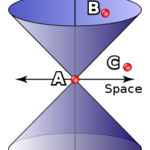
“Einstein’s general theory of relativity, proposed in 1915, revolutionized our understanding of gravity. It describes how mass and energy warp the fabric of spacetime, causing objects to move along curved paths. This theory suggests that the force we perceive as gravity is the result of this curvature, rather than a force acting at a distance, as described by Isaac Newton’s theory of gravity.
In simpler terms, imagine spacetime as a trampoline, and massive objects like stars and planets as heavy balls placed on it. These balls create dents or warps in the trampoline, causing smaller objects to roll towards them. Similarly, massive celestial bodies warp spacetime, causing other objects, like planets, to orbit them.
Einstein’s theory also predicts phenomena like gravitational time dilation, where time runs slower in stronger gravitational fields. This has been confirmed through experiments and observations, such as the bending of light around massive objects like galaxies.
In summary, Einstein’s general theory of relativity provides a deeper understandinghttps://www.rockstargames.com/ of gravity by explaining it as the curvature of spacetime caused by mass and energy, offering profound insights into the nature of the universe.”
Geometry of Newtonian gravity:
Classical mechanics, the foundation of many physical laws, explains how objects move. It says that motion is a mix of two types: free motion and deviations caused by outside forces, like pushing or pulling. Newton’s second law says the force on an object equals its mass times its acceleration. In simple terms, objects usually move straight and at a constant speed unless a force acts on them.
But when gravity enters, things get tricky. According to Newton’s law of gravity, objects fall the same way regardless of their mass. This means it’s hard to tell if you’re falling due to gravity or being pushed by a rocket. This idea leads to a new type of motion: falling under gravity. This kind of motion also shapes space and time, but in a more complex way than simple straight lines. The path of objects falling under gravity creates a curved spacetime.
Newtonian gravity can be reformulated using this curved spacetime idea, creating the Newton–Cartahttps://www.youtube.com/@petsascompanion8222n theory. This theory simplifies how we describe gravity using math, showing how mass causes the curvature of spacetime, affecting how objects move.
Relativistic Generalization:

Geometric Newtonian gravity is interesting, but it’s just one part of a bigger picture. Classical mechanics, the basic rules of motion, is like a simpler version of a more complex theory called relativistic mechanics.
Relativistic mechanics kicks in when things move really fast or have a lot of energy. Unlike classical mechanics, it follows different rules, especially when it comes to speeds close to the speed of light.
In this theory, we use something called Lorentz symmetry, which means the laws of physics stay the same no matter how you’re moving. It’s like how things look the same whether you’re standing still or moving smoothly in a straight line.
But when gravity gets involved, things change. We see this with freely falling objects—they don’t follow straight lines anymore. Instead, their paths curve because of gravity.
Special relativity, which doesn’t deal with gravity, works fine when gravity isn’t a big deal. But when gravity matters, we need to adjust our thinking. We’ve found that the rules of special relativity still apply pretty well in situations where gravity is at play. This idea is called the Einstein equivalence principle and helps us understand how gravity fits into our understanding of the universe.
Einstein’s Equations:
Einstein’s field equations describe how gravity works in simple terms. On one side of the equation, we have the Einstein tensor, which combines different parts related to space curvature and the way things move. It’s like a mathematical way of showing how space curves and affects objects.
On the other side, there’s a constant and something called the energy–momentum tensor, which represents the stuff in space that creates gravity.
When there’s no stuff around, the equations simplify to what’s called the vacuum Einstein equations, showing how space behaves without any matter.
In general relativity, objects move along paths called geodesics in curved space. It’s similar to how objects move in straight lines in flat space, but curved space changes their paths.
To understand the force in general relativity, we look at how objects move around massive things like planets or stars. We can calculate a total force that combines Newtonian gravity, centrifugal force, and relativistic effects, which describe how space curvature affects motion.
Einstein’s field equations describe how gravity works in simple terms. On one side of the equation, we have the Einstein tensor, which combines different parts related to space curvature and the way things move. It’s like a mathematical way of showing how space curves and affects objects.
On the other side, there’s a constant and something called the energy–momentum tensor, which represents the stuff in space that creates gravity.
When there’s no stuff around, the equations simplify to what’s called the vacuum Einstein equations, showing how space behaves without any matter.
In general relativity, objects move along paths called geodesics in curved space. It’s similar to how objects move in straight lines in flat space, but curved space changes their paths.
Einstein’s field equations






